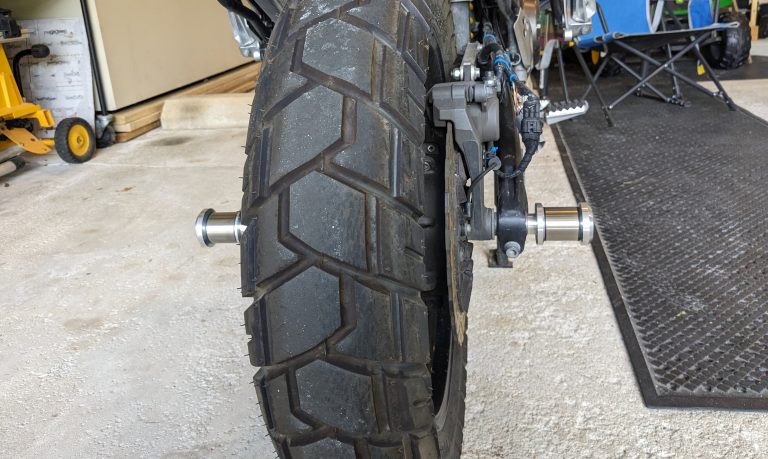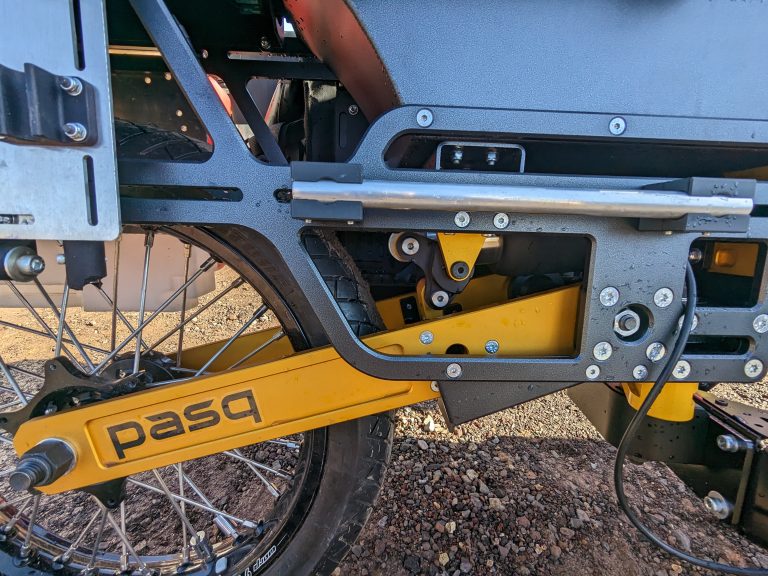Braking & the Trapezoid Hinge
We occasionally get a question about how the trapezoid hinge impacts braking. I understand the reason for the question. If you watch our video on how the trapezoid hinge works (below), you could get the impression that when you apply the brakes on the bike, the hinge will fold to the side and the weight of the trailer will slam into the bike, and that could impact the handling of the bike.
It’s important to point out that the above video was made with our proof-of-concept trapezoid hinge prototype (version 1 below). It was made with off-the-shelf parts to just prove the hinge would work. The picture below shows the version 1 hinge mounted between a wooden frame and our first prototype hitch arms. This setup is for demonstration purposes.
Once we were sure the trapezoid hinge was going to work, we started to design and build much more refined versions of it. A picture of version 2 is below—the yellow pieces are three of the four hinge arms. This picture is taken of our final prototype…duct tape will not be holding wires in our production models!
I can understand the thinking that movement in the arms would impact handling and braking, but I can tell you the hinge has zero discernable impact on braking or handling. Let me tell you a story and then I’ll explain what is going on:
Our Testing Story
The first time we tested the trapezoid hinge, we focused a GoPro on the hinge and started riding around the neighborhood to see first what would happen at slow speeds, turns, and stops. If that went well, we planned to go to a nearby quiet country road where we could do faster testing. At slow speeds what we saw on the video surprised me. I felt nothing while braking. There was no difference between the feeling of our previous fixed-hinge and the trapezoid hinge. I figured it wasn’t moving to the side. We watched the video, and I was wrong—the hinge was going to the side, but I didn’t feel it at all on the bike.
After some adjustments, we headed off to do some higher speed tests, including emergency braking tests. With the trailer loaded with 80 lbs. (36 kg) of sand we would get the Yamaha Super Tenere to 60 to 70 mph (100 to 112 km/h) and do a straight-line emergency stop. That meant we were engaging the ABS—the ABS was clicking—we’d bring the bike and trailer to a stop as quickly as the ABS would allow. I felt the weight of the trailer and the gear, but the hinge made no difference. We did the same test doing a slight curve. We tested going from 60-70 mph, and then slowing for a 90° turn, and then accelerating. There was no difference in feel at all. On all of these tests, the hinge did move to the side (which we could see on the video), but on the bike I felt no impact at all.
A Simple Look at the Physics
So, what’s happening? The arms of the hinge are 2.5″ (6.5 cm). That is not a very large lever arm, especially when you are considering that 180 lbs. (trailer + load) are being applied over that short of a lever.
Basic physics tells us that there must be some impact on the bike. But that same physics tells us that if you (at 180 lbs., for example) step onto a 2.5″ lever and try to lift a 580 lbs. bike, you are not going to have much of an impact on the bike. That is not a perfect analysis of what is happening, but it isn’t far off.
Lastly, once the hinge has rotated to the side, which usually happens rather gently, not a big slam, the impact of the movement of the hinge has been absorbed and no longer impacting the bike in any way.
We’ve done a large amount of testing of the hinge: how it handles in a wide variety of terrains, and in a wide range of turning and braking situations. We have not had any negative impacts from the hinge: only more stability of the trailer, which was the goal.






